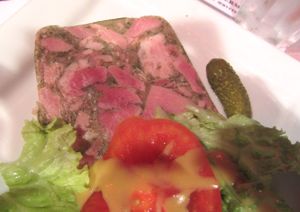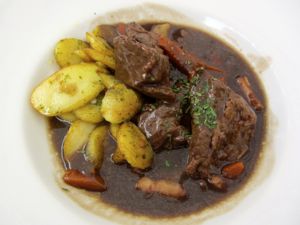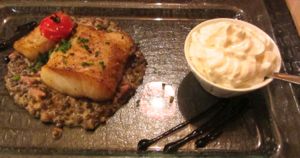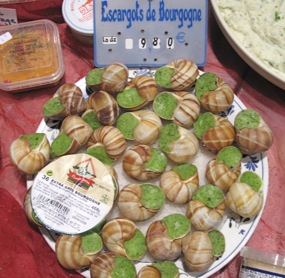 |
Food & Drink in Burgundy, France | |
| Burgundy has long been associated with some of the finest French food, and you're sure to eat well in the region. | ||
|
|
|
The Burgundy region is of course known for its wonderful wines, many of which are grands crus, the very best. It's also known for its delicious cuisine. You may want to try some of the following dishes when you're there. For appetizers (called entrées in French), you'll frequently see Escargots de Bourgogne and Jambon Persillé on menus. Less common (but also delicious) is oeufs en meurette. You may want to enjoy a Kir, or white wine and crème de cassis, with your entrée. Escargots de Bourgogne are snails, traditionally baked in the shell along with a lot of butter, garlic, and parsley. A normal serving is 6 escargots, and you'll get a special pincer to hold the shell and a small fork to poke out the snail. They're delicious, and be sure to use some French bread to mop up the buttery sauce. Escargots come in cans, properly cleaned and ready to be served. You can even buy shells, implements and a can of escargots so you can make them at home! Jambon persillé has been made and eaten in Burgundy for several centuries. Traditionally it was served at Easter, but now you will find it year round. It's a sort of country paté or terrine made with ham and pork, and covered in a layer of parsely-infused gelatin. Some jambon persillé that you'll see in markets will be very bright green while others are more subtle. It's a tasty start to a meal.
I learned to make oeufs en meurette (left) when I attended cooking classes in Dijon in 1968. Essentially, it's eggs poached in red wine. The sauce—with onions, bacon, and mushrooms—is virtually the same as you'll find with coq au vin or boeuf bourguignon. It's also a great brunch dish. The best known and most traditional main courses (plats principals) in Burgundy are boeuf bourguignon and coq au vin. Boeuf bourguignon, or Burgundy beef, is a hearty delicious meal, with lots of sauce to mop up with your bread. It includes browned beef, pearl onions, lardons (bacon), garlic, sauteed mushrooms, and a bouquet garni (thyme, bay leaf, and parsley). It's cooked in at least a couple of cups of red wine, and the sauce is then thickened with flour, resulting in a delicious meal. It might also include carrots and potatoes (as did the one in the picture, right). As for Coq au Vin, it's essentially the same thing, but made with chicken. Again, the rich sauce is delicious and permeates the meat. Neither of these dishes is hard to make, though it does take some time to prepare the vegetables and to cook the dish. You'll see them on many menus in Burgundy, and you can also make them at home. With them drink a nice pinot noir or other good red wine. For cheese, you might be offered époisses, a local cheese from the region. It's unpasturized and quite strong flavored. And you'll see a huge variety of cheeses in the markets (halles) of Beaune and Dijon. When it comes to dessert, many menus will have something made with cassis (black currant)—sorbet, a tarte, or something with a cassis sauce. More... Of course no page on the cuisine of Burgundy would be complete without acknowledging mustard. Dijon Mustard, or sometimes Moutarde de Bourgogne, is frequently used in cooking, making the salad dressings you'll eat, or on its own with sausages, steaks, or other meats. The local variety is hot and spicy and delicious, so be sure to try it. More... These are the most popular of the traditional dishes that come from Burgundy, and you are likely to be able to find them all in restaurants. Be on the look out for new creative meals as well, as Burgundy continues to be a leader in French cuisine. One of my more unusual (and delicious) meals in Beaune was cod served with lentils and a bacon-infused whipped cream! Bon appétit!
|
|
Above, Jambon persillé, in Beaune.
|




